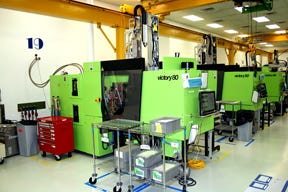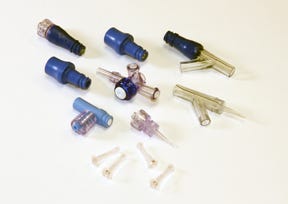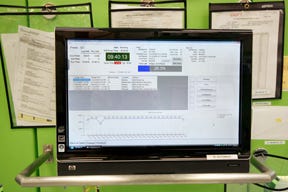In a bid to further optimize processes that currently churn out more than 1.6 billion parts each year, the molding andautomation division of IV therapy, oncology, and critical-care device supplier ICU Medical is developing its own process monitoring system, one that’s true to the principles of company founder George Lopez.
February 3, 2010
In a bid to further optimize processes that currently churn out more than 1.6 billion parts each year, the molding and
automation division of IV therapy, oncology, and critical-care device supplier ICU Medical is developing its own process monitoring system, one that’s true to the principles of company founder George Lopez.
“ICU is a company formed in the image of Dr. Lopez with an entrepreneurial spirit and a passion for customers,” explains Dave Zwald, general manager at ICU’s Murray, UT molding plant. “Our core values are providing products that are faster to market than our competition with better performance and features, and at a competitive cost. There’s no compromise on quality, but we are very responsive to meeting market needs with new products, which, as you can imagine, provides exciting challenges in designing and building with tooling for high-volume production.”
|
Firmly established in its existing lines, ICU is currently working toward expanding its product mix to provide cleanroom OEM molding of silicone and thermoplastic materials. In 2005, ICU Medical, which is headquartered in San Clemente, CA, transferred its molding from that site to Taylorsville, UT in the greater Salt Lake City area. Originally built in 1973 for Sorenson Medical, the plant covers three floors totaling 450,000 ft2. At present, it employs roughly 500 employees and runs 67 injection molding machines and 40 automated assembly machines.
The facility has three different, connected Class 100,000 cleanrooms dedicated to molding. Press clamp tonnage ranges from 65-310 tons, with Engels used for liquid injection molding (LIM), Toshibas for midrange parts, and five Huskys for high-speed applications.
Looking for a better way
Starting in the fall of 2009, ICU began work to create a process monitoring system that would display process parameters in real time on large LCD screens placed at the end of each press. Starting with one press as a beta site, the company began work with training and sensor supplier RJG Inc. (Traverse City, MI) to track cavity pressure in its tooling and install RJG’s eDart technology on all its machines.
“What we’re doing is taking the scientific approach, going right down into the shear curve,” explains Ron Forbes, ICU’s molding/tooling manager. “We want to see how the material is flowing into the cavity—really control the manufacturing process.”
The initial emphasis is on the multidurometer silicone plug that’s at the center of ICU’s Clave intravenous (IV) connector device. ICU began silicone LIM in 1991, and currently operates 19 LIM machines, all Engels. As part of its data testing, it considered all the equipment in the cell, from the screw and barrel to the silicone’s pump system. The facility has also begun implementation of the ICU Production System, based on the lean concepts advanced by the Toyota Production System.
Attached to the clamp end of the press is a large LCD screen in full color that acts as a touch-screen control, allowing operators to interact with the in-house-developed process monitoring software. In late 2009, 17 machines were utilizing the screens, with all presses to be outfitted in 2010, working toward a goal of no paper on the floor.
In addition to tracking and storing a range of parameters for each part in real time, the system can also shut down a press if it goes outside the set parameters. The goal is to display those process parameters in an SPC format along with real-time dimensional checks for the components themselves.
“Once you can control your manufacturing process,” Forbes says, “you can really start making gains and hitting your goals for reducing scrap, increasing productivity, and cutting cycle time, let alone improving part quality and shot-to-shot consistency.” In addition to each machine, the new system will display real-time information throughout the company, including in the office of company founder George Lopez.
Hot runners, hybrids heat up 
connector production
When Lopez, then a practicing internist, founded ICU Medical in 1984, its initial product was a locking mechanism for IV systems. Lopez developed that device after losing a patient due to an accidental disconnect of an IV line. Initially called the Click Lock, that first design consisted of a protected needle, which also prevented healthcare workers from being accidentally pricked. It has since evolved into the Clave connector, a one-piece, needle-free IV-connection device.
Nearly 10 years ago, ICU’s molding division examined the production process for the Clave, looking for ways to optimize its manufacture. Following that assessment, the company switched the device’s molding from 10 older machines to five new Husky Hylectrics. Located on what was predecessor Abbott Critical Care’s molding floor, the five Husky presses join 23 other machines in an area ICU plans to make its high-cavitation room. ICU also opted for Husky Ultra valve-gated (VG) hot runners instead of cold runners, and later implemented Husky’s UltraSync electric plate actuation and Altanium temperature controls.
The company says the switch to hot runners has resulted in faster cycles, increased productivity, reduced resin usage, and lowered energy consumption, all of which contribute to lower overall part cost. Running about a 15-second cycle, ICU says the Hylectric’s fast open (allowing falling parts to clear the platen) and equally speedy close (initiating the next cycle) were essential.
By eliminating cold runners and the time needed to cool them, ICU was able to shrink cycle times. In addition, the hot runner helped lower machine energy consumption because of reduced heating, cooling, plasticating, and injection requirements. Through simultaneous gate closing, UltraSync electric plate actuation technology allowed ICU to double cavitation on the thermoplastic part without affecting quality. After first utilizing three 32-drop pneumatic systems fitted with Ultra 500 nozzles, ICU now has three 48-drop systems and one 64-drop UltraSync electric plate actuation system for the Clave. ICU says the new system allows it to service the valve pins in the press, which cuts maintenance time required from 1-1.5 days to only a half day.
The new 48-drop hot runners were installed on existing injection molding systems, increasing ICU’s productivity while shrinking its footprint. Since startup, the first 48-drop system has run nearly a million cycles and is still going strong within a Tech Mold Inc. (Tempe, AZ) tool. —Tony Deligio
About the Author(s)
You May Also Like






